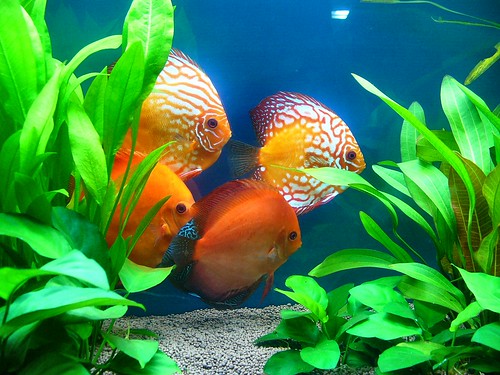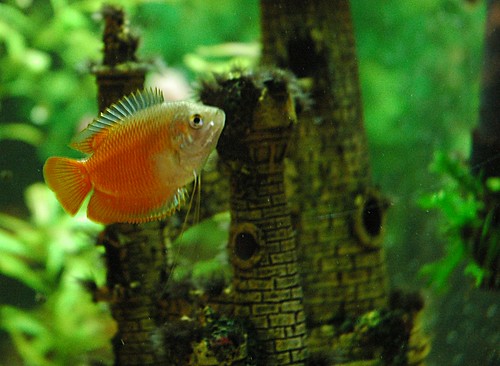 Enrichment
Enrichment
When people talk about enrichment and animals they are usually talking about enriching the lives of creatures like tigers, apes and parrots. Often not much thought is given to enriching the lives of fish. Many fish however have been shown to have some intelligence. Even guppies can count to the number four! Cichlids have often been considered very intelligent fish and many would do well to have some enrichment. With this in mind, perhaps it is time to start looking into how we can enrich the lives of our aquatic pals.
What is enrichment?
When we talk about enrichment concerning animals we are referring to improving their lives, stimulating them. Enrichment is a common topic among many institutions, such as zoos, that have animals. When looking to enrich an animals life its a good idea to start by looking at how they would normally behave in the wild and try to offer things that may trigger similar behaviors. For example, with many mammalian predators, keepers will often hide their food so they have to "hunt for it". Or they will put in large balls or other things that move when the animal touches it and this stimulates a prey drive. Primates are often offered puzzles and other things that stimulate their intellect. Without enrichment many captive animals become extremely bored, obese and some may even exhibit bizarre behaviors.
Enriching The Lives Of Fish
So, how would one go about enriching the lives of fish? Well, that would depend on the type of fish. For many fish, simply having tankmates and an interesting environment with a lot of visual barriers will be enrichment enough. For others you may need to get creative and utilize ping pong balls, a mirror or even a squeaky toy! Food can perhaps be one of the best enrichment tools available to animal keepers, try to get creative.
Tankmates
Tankmates can provide plenty of entertainment for many fish. Schooling fish such as barbs, tetras, rasboras and many more benefit most from being in groups of 6 or more of their own kind (for example, 6 neon tetras, not 1 each of 6 different tetras). They will spend most of their day reacting to each other, displaying, and working out their social hierarchy. Rock dwelling African cichlids spend much of their time in both the wild and captivity stealing and protecting favorite rock outcroppings and caves from each other. If your lone fish seems sedentary and bored with life, consider upgrading its tank size and adding some tankmates. Remember to research first what types of fish can live together. Environment
Environment
Use fake or live plants, driftwood pieces or other decorations to create a dynamic aquascape. Try to position decorations so that if the fish is in one section of the tank, it cannot see the other side without moving. This will stimulate most fish to always be on the move to check out what's "over there". If you have multiple fish this can also be a necessity, as it will give fish a break from each other if the needs arrives. Many fish, like botias and loaches love to check out caves and little nooks and crannies. You can make an interesting cave and tunnel system with PVC pieces, just make sure they are big enough in diameter that the fish won't get stuck. African cichlids also often enjoy PVC pieces. If you want a more natural look, use rocks and aquarium safe wood instead of PVC. For top dwelling fish, add floating plants (live or fake) and perhaps add a piece of wood that reaches all the way to the surface.
You need a big enough space to create an interesting environment. Try to avoid overstocking your tank with many small fish. If you have large fish, ensure the aquarium is large enough for the fish and some decorations.
Toys
Many large fish are kept by themselves because of the amount of tank space it would take to have appropriate tankmates. Oscars are a prime example. Many live alone in 75 gallon tanks with not much to do all day. Other fish live alone because they are aggressive or because they can survive in a smaller tank that only has room for one fish (bettas for example). Many of these fish are some of the most intelligent, and yet they are often the ones relegated to the most boring existence. Many of these fish will benefit from toys to play with, yes toys. Many larger cichlids will "play" with a floating ping pong ball, or will check out and manipulate with their mouths new items in their territory. One oscar seemed to enjoy a dog toy, it was a small squeaky toy. The oscar would carry it around, biting on it. Some toys can be used to hide food in, so the fish has to work to get its meal. If you decide to use a toy for your fish, make sure it will not negatively affect the aquarium water. With bettas, holding up a small mirror for a minute or so a day will initiate a threat display and give the betta some excellent exercise. They often appear to "feel proud" of themselves when the mirror is put away, for having chased away the opponent. You can even teach your fish to do tricks . . . such as play soccer, basket ball, or swim through hoops.
Food As An Enrichment Tool
Food can perhaps be one of the best enrichment tools available to keepers. One of the biggest delights of many aquarium keepers is feeding time. The fish become animated, excited. Its nice to see them enjoying something. Most people just toss in some flakes or pellet foods and in a minute, or even just a few seconds, it is over. In the wild fish have to work for their food. Finding and getting food preoccupies much of their day. In captivity it is something that takes up perhaps just a few seconds, once, maybe twice a day. So, how do you go about making eating more interesting? Well, that will depend on how your fish eat. You would feed a top dwelling fish differently than a bottom dweller and grazers differently than a predator.
Try adding live foods fairly often, such as brine shrimp. They will have to hunt them down and will often spend some time after they have eaten them all, looking for more. If brine shrimp are too small for your fish, try ghost shrimp instead. If you don't have access to live foods, put frozen foods into the filter current so they have to chase them down. Feed different types of foods, alternate between a flake food, a floating pellet and a slow sinking pellet. Feed in a different area, alternate sporadically between the left of the tank, the right, the middle, the front and the back. Try adding a live food that can survive and breed in the tank, such as a species of fresh water shrimp. Some people have successfully been able to keep a small population of daphnia alive in their aquarium. For bottom dwelling and grazing type fish (catfish; goldfish), drop one pellet here, one there, don't just drop them all in one spot. For predators, put food on the end of a feeding wand an make them stalk and hunt down their food. Many herbivorous fish, such as goldfish or silver dollars, will enjoy eating live plants; drop a bunch of anacharis (elodea) in the tank once in awhile. Some fish can learn to put a ball through a hoop or ring a bell to get fed. Again, just be creative and mix it up, your fish will appreciate it.
When it comes to enriching the lives of our aquarium fish it can be as simple as adding some tankmates and decorations, or as complicated as giving them toys to chase and push around, or rigging up an underwater basket ball game. Even the simplest forms of enrichment can make a huge improvement on their lives.
Interesting links:
Underwater Times: Man Trains Goldfish
Fish School - How To Train Your Fish
Picture credits:
loloieg, doviende, Whisper Photography, Tom@HK
Saturday, February 23, 2008
Enrichment
Posted by
Melgrj7
at
11:43 PM
![]()
Labels: aquarium, decoration, enrichment, fish feeding, toys, training fish
Subscribe to:
Post Comments (Atom)



No comments:
Post a Comment